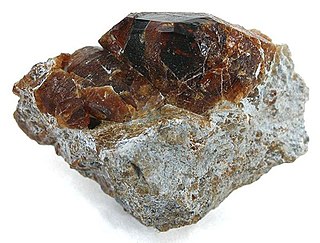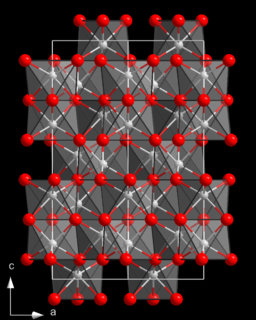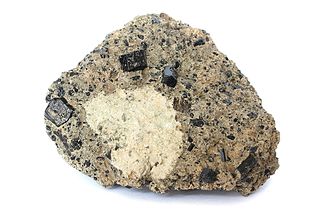Related Research Articles

Hibonite is a mineral with the chemical formula (Ca,Ce)(Al,Ti,Mg)12O19, occurring in various colours, with a hardness of 7.5–8.0 and a hexagonal crystal structure. It is rare, but is found in high-grade metamorphic rocks on Madagascar. Some presolar grains in primitive meteorites consist of hibonite. Hibonite also is a common mineral in the Ca-Al-rich inclusions found in some chondritic meteorites. Hibonite is closely related to hibonite-Fe ) an alteration mineral from the Allende meteorite. Hibonites were among the first minerals to form as the disk of gas and dust swirling around the young sun cooled.

Fassaite is a variety of augite with a very low iron content, Ca(Mg,Fe,Al)(Si,Al)2O6. It is named after the Fassa Valley, Italy.

Scandium(III) oxide or scandia is a inorganic compound with formula Sc2O3. It is one of several oxides of rare earth elements with a high melting point. It is used in the preparation of other scandium compounds as well as in high-temperature systems (for its resistance to heat and thermal shock), electronic ceramics, and glass composition (as a helper material).

Warwickite is an iron magnesium titanium borate mineral with the chemical formula (MgFe)3Ti(O, BO3)2orMg(Ti,Fe3+, Al)(BO3)O. It occurs as brown to black prismatic orthorhombic crystals which are vitreous and transparent. It has a Mohs hardness of 3 to 4 and a specific gravity of 3.36.

Chondrodite is a nesosilicate mineral with formula (Mg,Fe)
5(SiO
4)
2(F,OH,O)
2. Although it is a fairly rare mineral, it is the most frequently encountered member of the humite group of minerals. It is formed in hydrothermal deposits from locally metamorphosed dolomite. It is also found associated with skarn and serpentinite. It was discovered in 1817 at Pargas in Finland, and named from the Greek for "granule", which is a common habit for this mineral.

Melilite refers to a mineral of the melilite group. Minerals of the group are solid solutions of several endmembers, the most important of which are gehlenite and åkermanite. A generalized formula for common melilite is (Ca,Na)2(Al,Mg,Fe2+)[(Al,Si)SiO7]. Discovered in 1793 near Rome, it has a yellowish, greenish-brown color. The name derives from the Greek words meli (μέλι) "honey" and lithos (λίθους) "stone".The name refers to a group of minerals (melilite group) with chemically similar composition, nearly always minerals in åkermanite-gehlenite series.

Titanium(III) oxide is the inorganic compound with the formula Ti2O3. A black semiconducting solid, it is prepared by reducing titanium dioxide with titanium metal at 1600 °C.
Akimotoite is a rare silicate mineral in the ilmenite group of minerals, with the chemical formula (Mg,Fe)SiO3. It is polymorphous with pyroxene and with bridgmanite, a natural silicate perovskite that is the most abundant mineral in Earth's silicate mantle. Akimotoite has a vitreous luster, is colorless, and has a white or colorless streak. It crystallizes in the trigonal crystal system in space group R3. It is the silicon analogue of geikielite (MgTiO3).
Alluaivite is a rare mineral of the eudialyte group, with complex formula written as Na19(Ca,Mn)6(Ti,Nb)3Si26O74Cl·2H2O. It is unique among the eudialyte group as the only titanosilicate (other representatives of the group are usually zirconosilicates). The two dual-nature minerals of the group, being both titano- and zirconosilicates, are labyrinthite and dualite. They both contain alluaivite module in their structures. Alluaivite is named after Mt. Alluaiv in Lovozero Tundry massif, Kola Peninsula, Russia, where it is found in ultra-agpaitic, hyperalkaline pegmatites.

Kaersutite is a dark brown to black double chain calcic titanium bearing amphibole mineral with formula: NaCa2(Mg3Ti4+Al)(Si6Al2)O22(OH)2.
Panguite is a type of titanium oxide mineral first discovered as an inclusion within the Allende meteorite, and first described in 2012.
Gugiaite is a melilite mineral, named for the Chinese village of Gugia where it was first discovered. Its chemical formula is Ca2BeSi2O7. It occurs mostly in skarns with melanite adjacent to an alkali syenite and has no economic value. Its crystals are small tetragonal tablets with vitreous luster and perfect cleavage. It is colorless and transparent with a density of three. The mineral belongs to space group P-421m and is strongly piezoelectric.
Allendeite, Sc4Zr3O12, is an oxide mineral. Allendeite was discovered in a small ultrarefractory inclusion within the Allende meteorite. This inclusion has been named ACM-1. It is one of several scandium rich minerals that have been found in meteorites. Allendeite is trigonal, with a calculated density of 4.84 g/cm3. The new mineral was found along with hexamolybdenum. These minerals, are believed to demonstrate conditions during the early stages of the Solar System, as is the case with many CV3 carbonaceous chondrites such as the Allende meteorite. It is named after the Allende meteorite that fell in 1969 near Pueblito de Allende, Chihuahua, Mexico.
Scandiobabingtonite was first discovered in the Montecatini granite quarry near Baveno, Italy in a pegmatite cavity. Though found in pegmatites, the crystals of scandiobabingtonite are sub-millimeter sized, and are tabular shaped. Scandiobabingtonite was the sixth naturally occurring mineral discovered with the rare earth element scandium, and grows around babingtonite, with which it is isostructural, hence the namesake. It is also referred to as scandian babingtonite. The ideal chemical formula for scandiobabingtonite is Ca2(Fe2+,Mn)ScSi5O14(OH).
Hexamolybdenum, is a molybdenum dominant alloy discovered during a nanomineralogy investigation of the Allende meteorite. Hexamolybdenum was discovered in a small ultrarefractory inclusion within the Allende meteorite. This inclusion has been named ACM-1. Hexamolybdenum is hexagonal, with a calculated density of 11.90 g/cm3. The new mineral was found along with allendeite. These minerals, are believed to demonstrate conditions during the early stages of the Solar System, as is the case with many CV3 carbonaceous chondrites such as the Allende meteorite. Hexamolybdenum lies on a continuum of high-temperature alloys that are found in meteorites and allows a link between osmium, ruthenium, and iron rich meteoritic alloys. The name hexamolybdenum refers to the crystal symmetry and the molybdenum rich composition. The Allende meteorite fell in 1969 near Pueblito de Allende, Chihuahua, Mexico.
Dualite is a very rare and complex mineral of the eudialyte group, its complexity being expressed in its formula Na
30(Ca,Na,Ce,Sr)
12(Na,Mn,Fe,Ti)
6Zr
3Ti
3MnSi
51O
144(OH,H
2O,Cl)
9. The formula is simplified as it does not show the presence of cyclic silicate groups. The name of the mineral comes from its dual nature: zircono- and titanosilicate at once. Dualite has two modules in its structure: alluaivite one and eudialyte one. After alluaivite and labyrinthite it stands for third representative of the eudialyte group with essential titanium.
Labyrinthite is a very rare mineral of the eudialyte group. When compared to other species in the group, its structure is extremely complex - with over 100 sites and about 800 cations and anions - hence its name, with its complexity expressed in its chemical formula (Na,K,Sr)35Ca12Fe3Zr6TiSi51O144(O,OH,H2O)9Cl3. The formula is simplified as it does not show the presence of cyclic silicate groups. Complexity of the structure results in symmetry lowering from the typical centrosymmetrical group to R3 space group. Other eudialyte-group representatives with such symmetry lowering include aqualite, oneillite, raslakite, voronkovite. Labyrinthite is the second dual-nature representative of the group after dualite and third with essential titanium after dualite and alluaivite.
Davisite is an exceedingly rare mineral of the pyroxene group, with formula CaScAlSiO6. It is the scandium-dominant member. It stands for scandium-analogue of other pyroxene-group members, esseneite, grossmanite and kushiroite. Davisite is one of scarce minerals containing essential scandium.
Grossmanite is a very rare mineral of the pyroxene group, with formula CaTi3+AlSiO6. It is the titanium-dominant member. Grossmanite is unique in being a mineral with trivalent titanium, a feature shared with tistarite, Ti2O3. Titanium in minerals is almost exclusively tetravalent. Grossmanite stands for titanium-analogue of davisite, esseneite and kushiroite - other members of the pyroxene group. Both grossmanite and tistarite come from the famous Allende meteorite.
Tistarite is an exceedingly rare mineral with the formula Ti2O3, thus being the natural analogue of titanium(III) oxide. In terms of chemistry it is the titanium-analogue of hematite, corundum, eskolaite, and karelianite. Other minerals with the general formula A2O3 are arsenolite, avicennite, claudetite, bismite, bixbyite, kangite, sphaerobismoite, yttriaite-(Y) and valentinite. Tistarite and grossmanite - both found in the famous Allende meteorite (so is kangite) - are the only currently known minerals with trivalent titanium. Titanium in minerals is almost exclusively tetravalent. The only known terrestrial occurrence of tistarite was found during minerals exploration by Shefa Yamim Ltd. in the upper mantle beneath Mount Carmel, Israel.
References
- 1 2 Mindat, Kangite, http://www.mindat.org/min-42879.html
- ↑ Ma, C., Tschauner, O., Beckett, J.R., Rossmann, G.R., and Liu, W., 2013: Kangite, (Sc,Ti,Al,Zr,Mg,Ca,□)2O3, a new ultra-refractory scandia mineral from the Allende meteorite: Synchrotron micro-Laue diffraction and electron backscatter diffraction. American Mineralogist 98(5-6), 870-878
- ↑ Mindat, Tistarite, http://www.mindat.org/min-38695.html
- ↑ Mindat, Yttriaite-(Y), http://www.mindat.org/min-40471.html